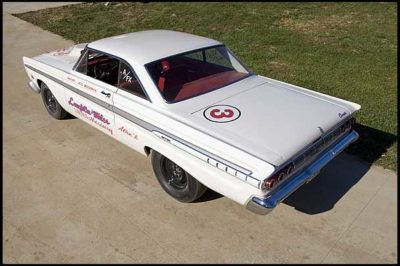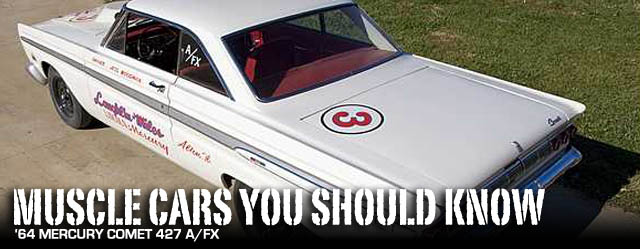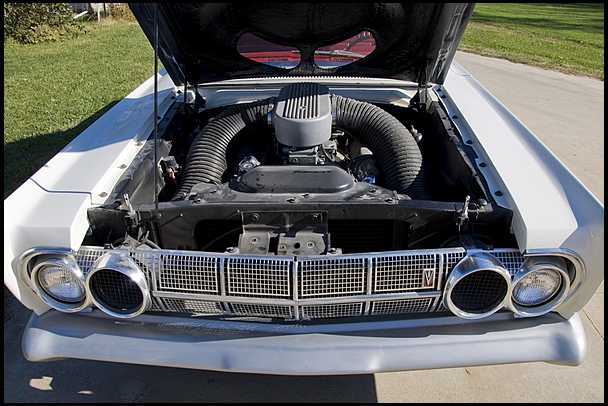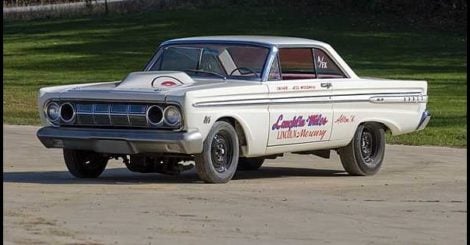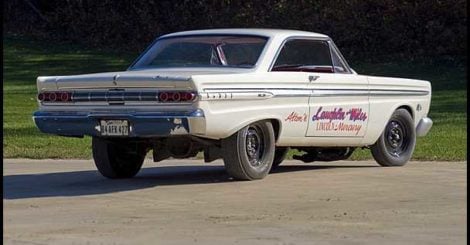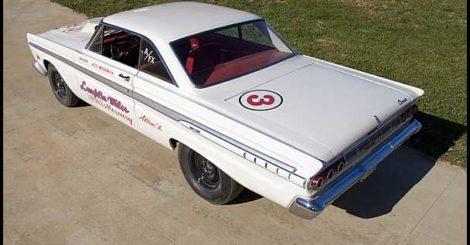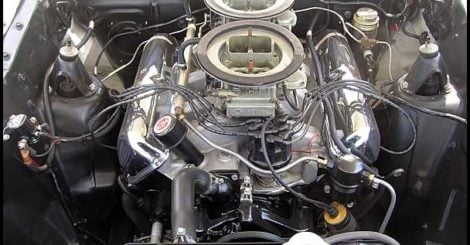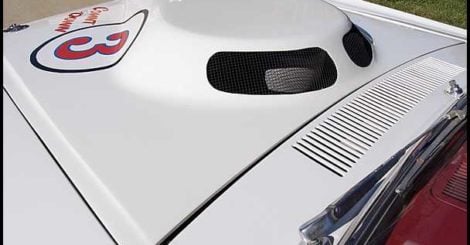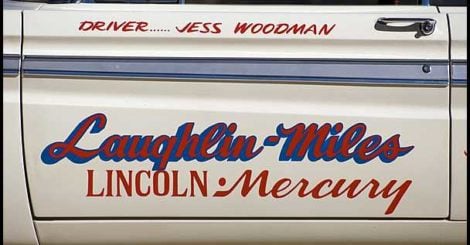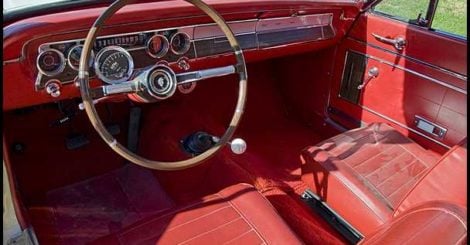While getting your hands on a factory-built race car was still a daunting task to anyone (except to those with strong inroads with Detroit or who dallied as weekend racers with factory racing support), walking into just about any car dealership in 1963 could land you a vehicle that had dual quads perched atop a stout big block and backed by a 4-speed transmission.
Ford’s titular “Total Performance [2]” program was an all-out assault on competitive racing. The promotional campaign sought to put the Blue Oval in the winner’s circle of a variety of motorsport venues.
Doing so meant a new-found emphasis on outright performance in all of Ford’s mainstream vehicles, specifically the Fairlane, Falcon, and Galaxie, which were heavily restyled to reflect this new performance image.
But Ford’s Total Performance program wasn’t all “talk” either. Though in very small quantities, “street legal” race cars were created by Ford, either due to demand or to meet homologation standards.
This usually meant – particularly in the early 1960s – the use of Ford’s venerable 427 side-oiler engine. Equipped with such, special editions of the Galaxie and Fairlane were created, namely the “Thunderbolt,” to rival entries from cross-town rivals Pontiac and Mopar.
And what about Mercury? While not under Ford’s Total Performance umbrella, sister brand Mercury also was active in racing. Their A/FX Comet was one of the hottest factory drag cars of the era, and goes unfairly forgotten in conversations.
A/FX (factory experimental) racing traces its origins back to the glory years of factory-sponsored Super Stock racing. When the Big Three couldn’t increase the power of their engines fast enough, they began to remove weight every which way (or, in the infinite words of Colin Chapman, “add lightness”).
The Comet was redesigned for 1964. Caliente trim level was used for A/FX coupes.
The A/FX Comets had a lot of success from 1964-65. Trim styling has made it a favorite.
Going On a Diet
In 1962, Pontiac began to offer aluminum components to racers, which reduced the weight of the Super Duty Catalina to a svelte 3,600 pounds. By 1963, all other manufacturers were using aluminum – save Ford, who used fiberglass components, most famously its “teardrop” hood.
The 427 was a strong contender in its high-riser form, but struggled shaking off the Mighty Mopars, although the ’64 Fairlane Thunderbolt evened the playing field a bit.
Pontiac upped the ante still by drilling holes in the frame of its light weight A-Bodies creating the now infamous “Swiss Cheese” Catalina. However, the fun at General Motors was short-lived as the big guys at the top floor of GM HQ said no more to factory-sanctioned racing.
The ranks of Super Stock racing was now left to Ford, Chrysler, and a handful of independents racing GM products, but the days of Super Stock were numbered anyway – the mechanical improvements from year to year were becoming marginal after 1962, plus the A/FX class allowed modified bodies, suspension, and wheels to make for wilder, more exciting racing. And, to be honest, Fords were notably heavier than the Mopars, didn’t have an automatic on par with Chrysler’s push-button, neutral-drop-surviving TorqueFlite, and those pesky Max Wedges and HEMIs.
The 427 was a strong contender in its high-riser form, but struggled shaking off the Mighty Mopars, although the ’64 Fairlane Thunderbolt evened the playing field a bit.
The equalizer between FoMoCo's lightweight A/FX entries and Mopar's was the potent high-riser 427. Equipped with set of high-dome pistons upping the compression up to 14:1, the tall intake was a pair of 780cfm Holley four-barrels while a pair of tube steel headers evacuated the spent gases.
Bringing Out The Big Guns
Meanwhile, Mercury was taking notice that sponsoring a popular drag team was a good way to sell cars, so they commissioned Dearborn Steel Tubing to build a Comet Caliente two-door hardtop and a Comet wagon. Aside of the obvious differences in body styles, the wagon also had a wheelbase shorter by over four inches. A high-riser 427 was installed with some fuss, but Dearborn Steel Tubing’s experience modifying the Thunderbolt certainly helped.
With Dyno Don Nicholson freshly minted into the Mercury ranks, he was given the choice of a Caliente coupe or the wagon; Dyno chose the wagon for its shorter wheelbase and heavier rear for better weight transfer. He wreaked havoc in Super Stock until the NHRA told him it was a non-production vehicle that required it to be refactored to the A/FX class.
The 427 for the A/FX Comet was part of FoMoCo’s FE series that had its beginnings in 1958 as a 332 and 352. In mid-year 1963, the 427 replaced the 406 and came in two configurations: The “Q-code” 410-horsepower version with a single four-barrel, and an “R-code” with dual quads and 425 horsepower.
Iconic to the A/FX entries from Ford were the aggressive and fully functional 'teardrop' hoods.
All A/FX Comets were white with red interiors.
However, for racing, FoMoCo created the “high-riser,” so named due to the raised aluminum intake manifold. The high-riser 427 was also distinguished by its redesigned cylinder heads, which featured larger ports with wider 2.19-inch and 1.73-inch intake and exhaust valves, respectively. A set of high-dome pistons and a redesigned combustion chamber upped the compression to a wild 14:1 ratio. Above the aforementioned tall intake was a pair of 780cfm Holley four-barrels while a pair of tube steel headers evacuated the spent gases. The rest of the R-Code package included a heavy-duty four-speed, and a nine-inch rear end.
The above changes didn’t change the factory horsepower rating, but obviously it was putting out well over 500 horsepower. The modifications didn’t stop there for the 427 Comet, which included a pair of fiberglass front fenders, hood, doors, and bumpers, Lexan side and rear glass, a lighter, six-cylinder radiator, radio- and heater-delete plates, and American Racing magnesium wheels up front.
Dyno Don eventually passed along the wagon prototype to Fast Eddie Schartman and received a “production” Comet Caliente, racking up 78 wins and one loss for the season. Fast Eddie updated the wagon with a 1965 nose and won Mr. Stock Eliminator at the ’65 Winternationals. But it wasn’t just big names winning races with one of the 21 white and red A/FX 427 Comets – Laughlin Miles Lincoln-Mercury of Alton, Illinois campaigned “Countdown 3” (so named because of the red-yellow-green lights of the Christmas tree) to numerous wins. It sold at the Mecum Auction in Kissimmee, Florida in January, 2011 for a cool $175.000.
CHECK OUT OTHER MUSCLE CARS YOU SHOULD KNOW
- ’68 Chevrolet Chevelle 300 327 L79 [11]
- ’69 1/2 Plymouth Road Runner 440-6 #1 [12]
- ’67 Buick California GS [13]
- Dick Landy’s ’70 HEMI Dodge Challenger R/T [14]
- ’70 AMC AMX/3 Supercar Concept [15]
- ’71 AMC Matador Machine 401 [16]
- ’67 Plymouth [17]HEMI [17]GTX “Silver Bullet” [17]
- ’71 Baldwin Motion Phase III GT [18]
- ’63 Chevrolet Z11 Impala 427 [19]
- ’64 Chrysler Ghia Turbine Car [20]
- ’63 Pontiac Catalina Lightweight 421 [21]
- ’69 Mercury Cougar BOSS 429 [22]
- ’69 Royal Bobcat Pontiac GTO Ram Air V [23]
- ’87 Buick Regal GNX [24]
- ’69 Ford Mustang BOSS 302 George Follmer’s #16 [25]
- ’69 Ford Mustang BOSS 429 [26]
- ’69 Dodge Charger Daytona #88 [27]
- ’69 Motion Chevrolet Camaro Z/28 427 ZLX [28]
- ’69 Motion Hurst/Oldsmobile 455 [29]
